SUNDAY
FEBRUARY 14 - 2016
Wayside
flowers
As I was
walking down Warblington Road towards Nore Barn this
morning I was pleased to find a very good display of
Sweet Violets in full flower on the grass verge
just before the junction with Valetta Park. I would
estimate a good 100 florets.

Further along
Warblington Road just before the Beach Road junction
there was also a good flowering of Three-cornered
Garlic against a garden fence. The flowers of
Three-cornered Garlic are similar to those of Summer
Snowflake except they have a narrow green stripe down
the centre of each petal, whereas the petals of the
latter plant have green tips.

Bullfinches
nesting
Caroline and
Ray French Ray had a walk around Stansted today and
came across a pair of Bullfinches in Hare Warren.
Caroline thought she heard a snatch of Bullfinch song,
but certainly saw the female with nesting material in
her beak. The BTO 'Field Guide to Monitoring Nests'
states the main breeding period for this species is
May to mid-August (2-3 broods), with some eggs laid in
mid-April, so this is very early to be nest building!
Here is a shot of
a female Bullfinch taken by Patrick Murphy in his
garden

Caroline's other
observations included about 70 Fieldfares and about 30
Redwings, but no Yellowhammers, Skylarks or Woodlarks
unfortunately. Caroline also had her first Blackcap of
the winter in her garden.

Dolphin/Porpoise
sighting?
Barry
Kingsmith was on the Hayling Bridge when saw what he
thought was either a Dolphin or a Porpoise about 400
yards towards Emsworth cruising around the mooring
buoys. Asked for more details, Barry said, "I first
spotted a small dorsal fin circulating among the
moorings. Then I watched and could see that it came up
for air every 30 odd seconds. It was about 3 to 3.5
feet long." I don't recall having had a report of a
Dolphin/Porpoise in our local harbours before. How
unusual are they?
Emsworth
to Warblington
Peter
Milinets-Raby was out this morning for his regular
bird survey/count along the shore from Emsworth to
Warblington (7:28am to 10am - low tide
throughout):
Emsworth Harbour: 1 Raven (patch tick for me)
heading east towards Thorney Island and calling
several times, 492 Knot, 8 Gadwall, 14 Canada Geese,
140+ Dunlin, 8 Red Breasted Merganser, 1 Great Crested
Grebe, 3 Little Egret, 2 Greenshank (RG//-+BYtag//), 1
Mediterranean Gull in almost full summer, 3 Coot, 180
Brent Geese, 1 Grey Heron over, 21 Shelduck, 2 Great
Black-backed Gulls, 3 Grey Plover, 16 Lapwing, 6 Teal,
6 Turnstone and a pair of displaying Goldeneye.
Pond Outflow (from 8:12am): 2 Teal and 1 Dunlin
Beacon Square (from 8:19am): 4 Shelduck, 84 Dunlin, 2
Grey Plover, 1 Knot, 3 Teal and 2 unringed
Greenshank.
Nore Barn (from 8:32am): 11 Pintail in the muddy
gullies, 31 Teal, 47 Dunlin, 11 Shelduck and 3 Grey
Plover.
Warblington Cemetery: 1 Goldcrest, Ibis Field: 2
Moorhen. Fields behind Conigar Point: 6 Skylarks - one
singing away.
Conigar Point (from 9:05am): 5 Shelduck, 58 Dunlin, 1
Great Crested Grebe, 4 Teal, 3 Grey Plover, 1 Red
Breasted Merganser, 3 Mediterranean Gull (all in
summer plumage), 2 Pintail and winter male Reed
Bunting singing half heartedly from the mini reed
bed.
Pook Lane (from 9:25am): 36 Shelduck, 7 Red Breasted
Merganser, 48 Lapwing, 27 Golden Plover, 8 Knot, 6
Grey Plover, 80+ Brent Geese and 71 Dunlin,
In fields by Castle Farm: 7 Brent Geese (With the
ONLY two Juveniles in the area - wow!!! See
photo). 7 Little Egrets, 9 Oystercatchers and 20
Curlew.

SATURDAY
FEBRUARY 13 - 2016
Request
for 'Swift Groups'
Swifts are in
serious trouble. The latest Hampshire Bird Atlas shows
that Common Swifts have declined by 64% over the past
two decades. A major factor in this decline is loss of
nest sites. To reverse this trend 'swift groups' have
been set-up in many parts of the UK and Europe to
assist householders to add nest sites to their houses,
to create new swift colonies by installing artificial
nest sites on churches, industrial buildings and
bespoke swift towers and to stimulate local interest
in these fabulous birds. Keith Betton of the Hampshire
Ornithological Society thinks we need Swift groups in
Hampshire! Although there are some individuals working
on Swifts, there are no 'Swift groups' as such.
Typically a 'Swift group' consists of a group of local
people who spend a little spare time assessing the
local swift population, identifying potential risks
(e.g. imminent renovation of a house), find sites
where new colonies could be encouraged and generally
spread the word about swifts. There is a lot of
information available as this is a tried and tested
formula (Google "Swift conservation" for example). If
you are interested in being involved in a local Swift
group email on keithbetton@hotmail.com
Living in Bridge Road
Emsworth for the past 20 years, we have been lucky to
have had a good population of Swifts flying over the
area in summer. We always look forward to the first
arrivals in early May, but best of all is to watch and
hear the family groups screaming around the houses
later in the summer before their all too early
departure in late July. However, I have never
discovered where they nested, though I suspect it must
be somewhere fairly local. I used to see what I assume
were youngsters prospecting potential nest sites in
holes in a neighbour's roof, but I am sure they never
nested there. If anyone has any information about
Swift nesting in the local area, please let me know.
Here is a snap of
a Swift passing over our house in July 2014
 .
.
I include Swifts in my
Garden BirdWatch reports as they hunt for insects over
the garden. The maximum number I have recorded was 60
in 2003, though 15-20 was the usual range up about 5
years ago. But since then numbers have crashed and the
most I saw last summer was 4. It was always so good to
see them screaming around the houses. We shall miss
them if they go.
Picture
gallery
Rock Pipit at
Southsea Castle by Leighton Barrable - 13 Feb 2016

Garden
bird changes over the years
I have just
completed the data analysis of my garden bird
sightings for the year 2015 and here are charts
summarising a few of the main findings from 1997 when
we first moved into the Bridge Road house to 2015. All
my sightings are entered into the BTO Garden BirdWatch
scheme. Note: all these charts (except the last one)
show the mean weekly counts of each bird in the
garden.
Some birds have
increased dramatically over this period, particularly
Goldfinch. I am fairly sure they first came in with
the introduction of niger seeds, though, in my garden
at least they have switched totally to sunflower
hearts. They are ever present every day and are very
messy eaters.
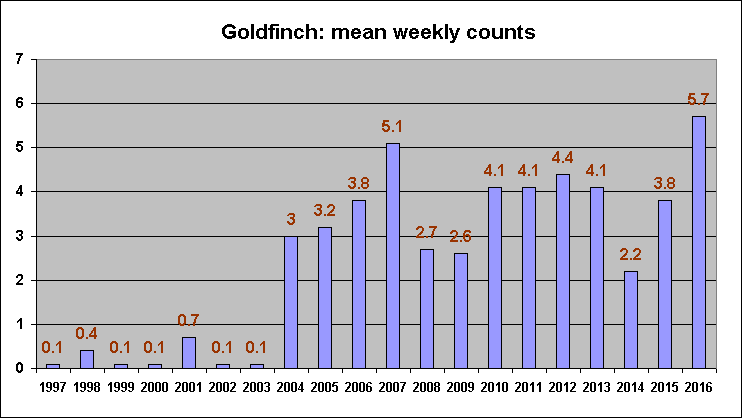
The other main
beneficiary of garden bird feeding over this period
has been the Woodpigeon which has increased steadily
from 1998 to 2008, but have levelled off since then. I
still see them in the garden everyday without fail.
This is a national trend and Woodpigeon is often the
number one ranked garden bird in theGarden BirdWatch
list.

Greenfinch was my
number one bird from 1998 to 2006, but then numbers
fell dramatically due mainly to the disease
trichomonosis. There are definite signs of their
recovery, but there is a long way to go. I am now
getting up to 6 birds on the feeders.
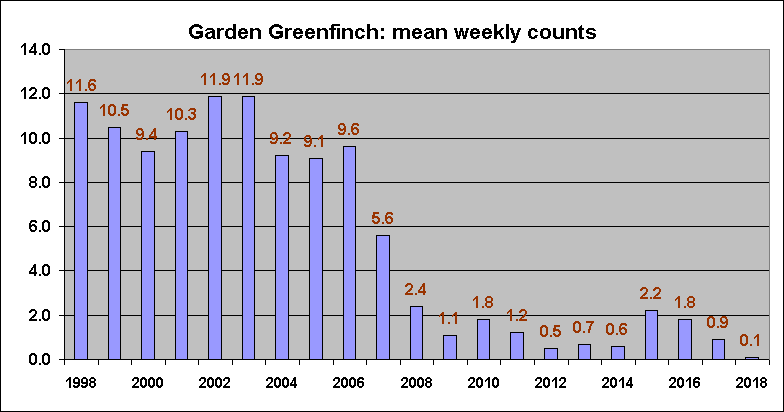
Chaffinch was another
bird that was affected by the trichomonosis outbreak,
though less seriously than Greenfinch.
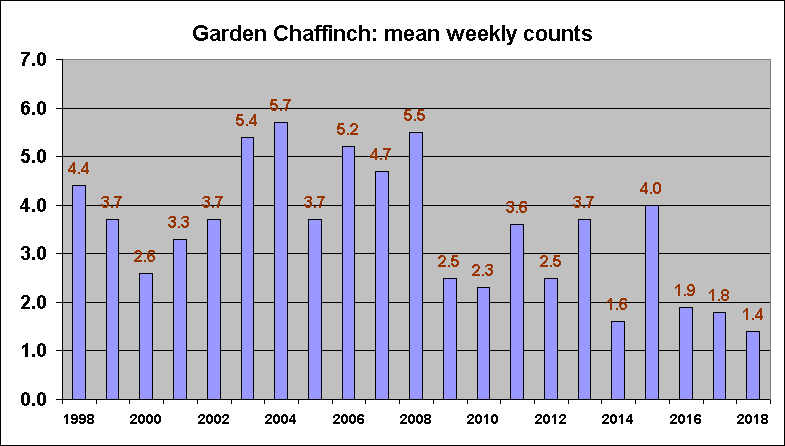
I am not sure if
Collared Dove was affected by trichomonosis, but its
numbers declined at about the same time - 2008. Before
that Collared Doves showed a steady increase over the
years.
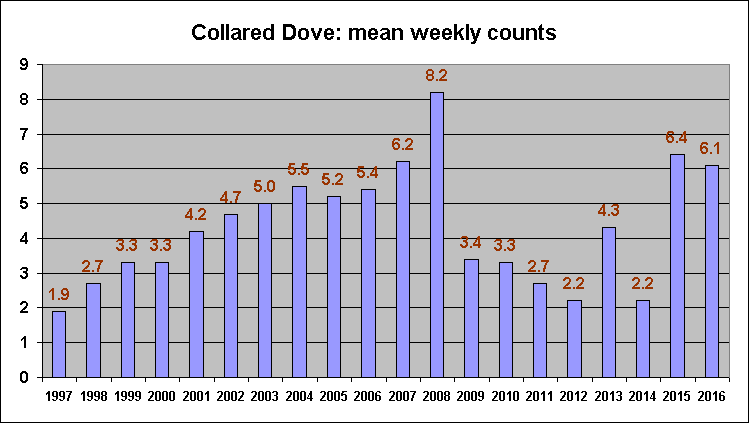
As expected from
national figures House Sparrows have gone down
dramatically over this period in my garden, though
there does seem to be some recovery over the past few
years. I am now seeing up to 4 House Sparrows, though
not regularly.
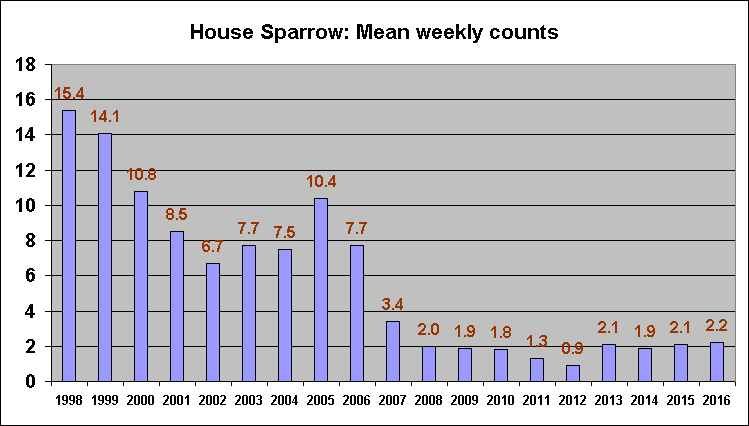
The decline in
Starling numbers coming into the garden has been even
more marked than that of House Sparrows. I used to get
huge flocks sweeping down to gobble up food and the
shoot off in a swishing cloud, but no longer. However,
I have noticed some improvement over the past year, so
there is hope.

Song Thrush numbers in
the garden have also crashed after a peak in 2005 when
they were seen in every week of the year. Now having
one in the garden is a big event. I only saw them
twice last year. Note: this chart shows percentage of
weeks a Song Thrush was recorded. in the garden.
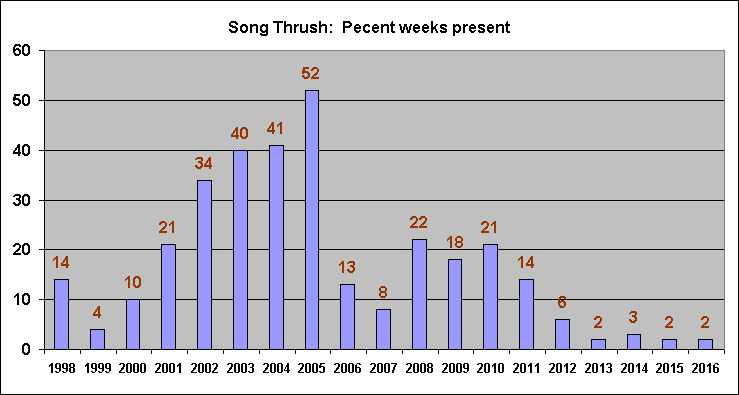
FRIDAY
FEBRUARY 12 - 2016
Swan
news
The Mute Swan
situtation on the town millpond seems to have settled
down. The lone swan with the loose feather on
its right side was actually on the pond near the end
of Nile Street when I arrived this morning (see
photo), but it retreated to a safer spot near the
culvert entrance when I returned later, although the
dominant pair were not in sight. It looked in
reasonable condition with no obvious sign of injury
following its encounter with the dominant pair a few
days ago. There was no sign of any other swan under
the grill or on the pond, so it looks like there is
only one swan taking refuge in the culvert.

Meanwhile, the
dominant pair of swans were again patrolling the
small wall between the millpond and the harbour even
though the tide was right out and there was no sign of
any other swans in the harbour and no chance of any
getting onto the pond with the water so low in the
harbour. Daft really, but that's swans for you.

Short-eared
Owls on Thorney
Claire Power
has been seeing Short-eared Owls on Thorney Island
again. Yesterday she saw 3 individuals. "They were
very active between 1.30 and 3 pm and a joy to watch.
Two of them kept having a bit of a spat. They like the
grass around the runways and the perimeter road - they
are often visible from the footpath that runs around
the island especially a short distance south, and a
short distance north of the sailing club. They seem
unperturbed by being on a busy army base and were
flying quite near people. Soldiers were doing speed
tests with cars on the runways today and the owls did
not seem bothered at all."
Claire managed to get some excellent photos of the
birds both perched and in flight. One of her photos
(lower left below) shows a bird with its ear tufts
erect which happens which the bird is alert and
attentive. When the bird is relaxed the ear tufts are
folded and become barely visible. The raised tufts are
illustrated in the Collins Bird Guide (p.213).
Two more Short-eared
Owl sightings were reported to me today. Ros Norton
saw one flying low and apparently hunting in a field
between Great and Little Deeps at 1.55pm. It then flew
west across the harbour. Christopher Evans also saw
one quartering over Southmoor but too far away for a
photo. He thinks it may be the same one that he saw in
December and early January, but haven't seen for over
a month.
Gulls
return to Hayling Oysterbeds
Chris Cockburn
reports on the return of a noisy crowd of Black-headed
and Mediterranean gulls at the Hayling Oysterbeds 3
days earlier than usual. He says, "they were mostly
swimming on the lagoon's waters; but occasionally
visiting both of the islands. Much calling,
particularly by the Mediterranean gulls, a bit of
displaying and even a bit of dive-bombing a herring
gull. Mind you, it was an exceptionally nice day -
warm sunshine, especially in places sheltered from the
cool but light breeze, Everybody I met was smiling and
ready to chat; such days make all the difference
during (what passes for) winter"
Mixture
of Black-headed Gulls and Mediterranean Gulls at
Hayling Oysterbeds

Meanwhile, Mike Wells
got an excellent shot of one of the finest wildlife
spectacles you can see in the local area - a flock of
Dunlin going up in a massed flight over Hayling
Oysterbeds.

THURSDAY
FEBRUARY 11 - 2016
Brook
Meadow
It was a
lovely morning with frost on the ground, a warm sun
and no wind. What a change to the ghastly weather we
have been having. I decided to have a walk through
Brook Meadow, the first I have had since the big
clearance by the conservation group in the north-east
corner. They certainly have opened up the area which
should encourage new growth and wild flowers, as well
as deterring vandals, which was the main objective of
the work.
Photo showing the
group at work on the site last Sunday

There was certainly a
touch of spring in the air with birds singing
everywhere. Wrens outnumbered Robins for the first
time this year. I also heard two Great Tits, Dunnock
and a Woodpigeon singing. But best of all were the two
Song Thrushes singing lustily, one in the
north-east corner and one by the Lumley gate. I
stopped for a few minutes to enjoy the thrush's
vigorous song and to take photos.

What a fine bird, but
I rarely see one in my garden these days. The
following chart shows how Song Thrush sightings in my
garden have declined over the past 10 years or so from
a peak in 2005 when at least one was seen every week
of the year.

I walked by Peter Pond
along the path alongside Gooseberry Cottage and
spotted a Kingfisher flying across the pond. It
settled briefly on a post on the east side allowing me
a distant photo before it shot off again. It was
probably the same female bird that Malcolm Phillips
got in flight yesterday.

Photo
gallery
Here are a few
of the excellent photos I received today, in no
particular order!
Black-headed Gull
in skimming the water by Malcolm Phillips

Purple Sandpipers
buffeted by waves at Southsea Castle by Barrie Jay

Little Egret in late
sun near Milton Locks by Leighton Barrable
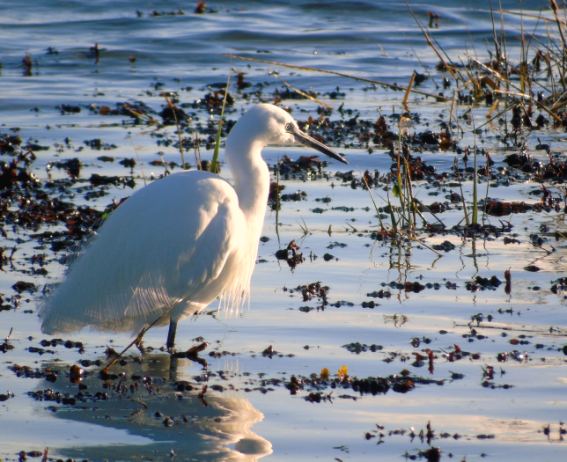
Male Goldeneye riding
the waves at Rye Harbour by Tony Wootton
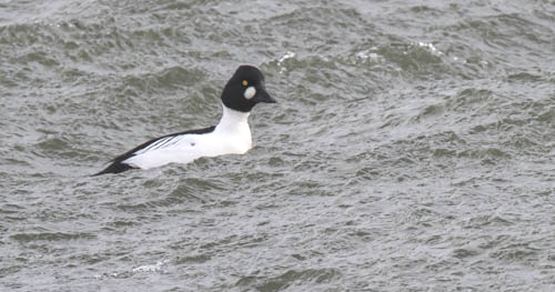
WEDNESDAY
FEBRUARY 10 - 2016
Millpond
Swans
The mystery of
what is happening to the Mute Swans on the millpond
appears to be resolving, at least in my mind, having
studied and pondered them for the past couple of
weeks. I am now fairly confident that the pair of
swans currently dominant on the pond is the pair that
was previously 'visiting' and which used to be
prevented from encroaching any further north than the
end of Nile Street by the nesting pair. This morning
this pair was patrolling the wall between the millpond
and the harbour, as they were yesterday, against any
encroachment from another pair of swans in the
harbour. One member of this pair is easily identified
by three feathers sticking up from its wing on the
right in the photo.

This newly dominant
pair appear to have ousted the resident pair that have
nested successfully on the millpond for the past three
years, at least one of which, and maybe both, is
currently trapped in the culvert that goes under the
main road. I went past the grill at the corner of St
James Road twice today and I am pretty sure there was
a different swan under the grill on each occasion; ie
only one the swans had the distinctive single loose
feather sticking up. However, I have not seen both
adults at any one time, though I have seen a cygnet,
so maybe there are three swans in the culvert?
This afternoon, I happened to be present when one of
the ousted swans emerged briefly from the culvert
opening onto to the millpond (see photo on the left),
but it did not stay long once it caught sight of the
dominant pair steaming down the pond towards it (see
photo on the right). How on earth are these swan going
to escape from the culvert with the very aggressive
dominant pair ever watchful?
Malcolm's
news
Malcolm
Phillips got a cracking photo of the female Kingfisher
taking off from the table on Peter Pond.

He then went over to
Langstone Mill Pond where he got some more excellent
images of a Water Rail on the path and a
Grey Heron in the trees at the back of the pond
- probably nesting.
Warblington
shore
Peter
Milinets-Raby was out this morning for a walk from
Pook Lane track down to the shore then along the coast
to Conigar Point and back via Castle Farm (10:15am to
Noon - high tide). In the field by Castle Farm barn
were 20 Little Egrets. In the field by the Pook Lane
track were 46 Curlew and 26 Oystercatcher.
Along Pook Lane track: Sparrowhawk, Buzzard. Off Pook
Lane: (see photo of continuing sea erosion), 15
Lapwing, 168 Brent Geese, 2 Great Crested Grebes, 2
Red Breasted Merganser, 3 Shelduck. Field south of
Warblington cemetery: 122 Brent Geese, 1 Curlew.
Off Conigar Point: (nice gathering of 22
Oystercatchers - see photo), 7 Teal, 7 Red Breasted
Merganser, Red Necked Grebe - distant - swimming into
the Northney Marina and resting between the yachts, 4
Little Grebe in the marina, 2 Shelduck, Great Northern
Diver eating crab and diving a lot, 2 Great Crested
Grebes.
In field behind Conigar Point: 3 Skylarks, Ibis Field:
4 Moorhen. Warblington Church: 2 Goldcrest (one
singing),
Popped briefly in the Nore Barn at 12:15pm to 12:29pm
- high tide, Goldcrest singing, 92 Teal, 16 Red
breasted Merganser, 2 Great Northern Diver (one being
the bird seen off Conigar Point - fishing by the same
yachts "Two Halfs", the other over towards Beacon
Square), 1 Great Crested Grebe, Best birds of the day
were 6 Snipe holding onto the last piece of tidal
marsh.
Then, later in the day I popped to Langstone Mill Pond
(2:02pm to 3pm - still high tide)
Off Pook Lane: 2 Great Crested Grebes, 3 Red Breasted
Merganser, 19 Teal, Kingfisher dashing across the bay
and landed on the roof of the Mill.
Langstone Mill Pond: 2 adult Mute Swans in full
display - no juveniles around! A pair of Tufted
Ducks
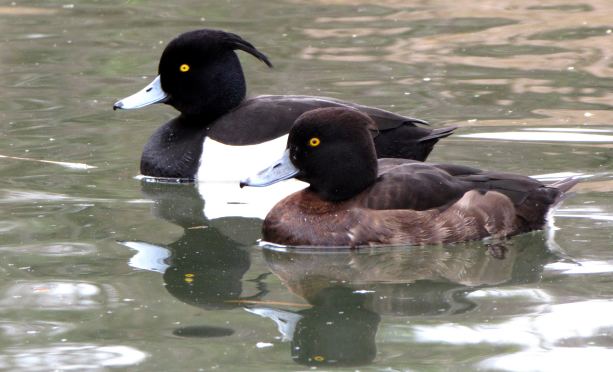
Link to a video of the Tufted Duck . . .
https://www.youtube.com/watch?v=S3Oc7LMxPAo
Second best bird of
the day - 3 beautifully looking almost summer plumaged
Med Gulls flying over calling! Great sound, the first
of the year - spring has finally arrived!! Grey Heron
colony - Almost constant call of young from the Holm
Oak.
Flooded Hose Paddock: 22 Wigeon, 65 Teal - loads of
the males displaying, 4 Oystercatcher, 25 Moorhen.
Garden
Siskins
Paul Cooper
who lives in Funtington has had two Siskins visiting
his garden occasionally, the first for some years. He
also had a charm of 32 Goldfinches eating niger seeds
from two feeders and those fallen on the lawn.
John Walton who lives in Waterlooville has also had
Siskins on his feeders - a maximum of 3 to date. He
got a photo of all 3 on the same sunflower hearts
feeder this morning. I am envious!

TUESDAY
FEBRUARY 9 - 2016
Millpond
Swans
On the way
down Bridge Road towards the town millpond this
morning I stopped at the corner of St James Road where
I could see the lone swan still trapped beneath the
grill. It looked in reasonable condition, though its
head was scraping the grill as the level of the stream
was much higher than yesterday.
I then walked up Bath Road and round the millpond
promenade. It was very pleasant in sharp contrast to
yesterday when I was almost knocked over by the wind.
Today, the wind had dropped and the sea was dead calm.
Quite amazing.

When I got to the
Slipper Mill Sailing Club I found two pairs of Mute
Swans squaring up to each other, one pair inside the
pond retaining wall and the other in the harbour
outside. One of the millpond swans (cob) had clambered
onto the retaining wall from which vantage point he
could easily threaten the other swan (cob) in the
harbour. The other millpond swan seemed unable to get
onto the wall, but had three loose feathers sticking
up from its wing, identifying it as one of the
millpond pair that have recently been dominating the
millpond. I am not sure about the identity of the
harbour pair. They could be the old nesting pair, or
the old visiting pair, or even a completely new pair.
The photo is taken from the narrow metal bridge
looking towards the harbour. Only one of the harbour
pair can be seen in the photo.

All this leaves the
swan in the culvert grill unaccounted for. I used to
think this was one of the original nesting pair ousted
by the invaders, but now I am not so sure. It could be
a swan coming in to try its luck, but failing to get
past the resident pair. I am confused!
Short-eared
Owls on Thorney
Claire Power
e-mailed to say she had seen two Short-eared Owls on
Thorney Island yesterday evening. I will leave Claire
to describe her exciting experience:
"I
went to the sailing club on the southern tip of
Thorney Island at 9 pm to check on my boat after the
strong winds. There is often a Short-eared Owl to be
seen quartering the field near the sailing club (not
visible from the footpath around the edge) so I kept
my eyes peeled. Sure enough, on the way back a
Short-eared Owl was evident flying along the road then
landing. I watched it from a short distance. It was
sitting on the road using the grass around the edge of
the road as a windbreak and preening/looking around
etc. Once it flew off, but just a very short distance
up the road where it did the same thing on the side of
the road. It seemed completely unbothered by my car
and lights (just side lights) and I watched it for a
good 30 minutes. I have attached a photo -
unfortunately I only had my phone - but it shows it
sheltering from the wind, which is coming from right
to left in the photo. It doesn't really show its
amazing bright yellow eyes.

Then
as I drove off the island there was another
Short-eared Owl on the road out from the gate post
towards Thorney Road. It was doing the same thing -
sitting on the side of the road using the grass as a
windbreak. Interestingly, it was sitting under a
street lamp. It was more car shy and flew up into a
tree as I slowly approached. It was definitely a
different bird as I drove straight from one and then
saw the other maybe a mile later.
I am not sure if short eared owls are more common this
year but they seem a lot easier to spot. I went to
Farlington Marshes in January a few times and the
first couple of weeks there routinely seemed to be 3
or 4 of them there, though more recently I have only
seen one, and that was a couple of weeks ago. There
don't seem to be any reported there on Going Birding
recently. I wonder if the Thorney ones could have come
from there?
The other place I have seen a Short-eared Owl this
year is at Walderton, quartering the field on the
corner where you turn right into Walderton from the
Lordington-West Marden Road. But I have only seen one
there once, even though I bike there a lot and keep
checking. I hope they are more common as they are such
stunning birds."
Claire is quite right.
It has been a good winter for sightings of Short-eared
Owls. In addition to those on Farlington Marshes, I
have received sightings from Nutbourne (Jan 20 and Feb
5) and Thorney Island where Anne de Potier reported at
least two Short-eared Owls working the pasture and
rough grassland in the southwest of Thorney Island for
several hours on the morning of Feb 4. These could
have been the same ones that Claire saw, though I
would guess there were more than two on the island. I
was interested to read in the spring 2016 issue of
'Kingfisher' (Newsletter of the Hampshire
Ornithological Society) that the editor received so
many recent Short-eared Owl pictures that he put them
onto a two page spread. These birds are certainly very
photogenic. Here is a particularly nice photo of a
Short-eared Owl in flight over the fields of Thorney
Island taken by Romney Turner a few years ago.

Short-eared Owl
migration
October is the peak month for Short-eared Owls
arriving from their northerly breeding grounds. Around
1,400 pairs of Short-eared Owl breed in Britain,
mainly in the Pennines and the Scottish uplands and
islands, but we only see them here in the south on
spring or autumn passage or wintering. The BTO
Birdtrack reporting rate shows a clear peak in mid
October, perhaps as a result of arriving and departing
birds being found in well-watched coastal areas. See .
. . http://bto-enews.org/NXN-3PEK7-3GJW16-1SGUDF-0/c.aspx
More
Shags
It also looks
like it has been a good winter for Shag sightings.
Leighton Barrable had another couple of sightings
today in Southsea. One was on the sea off the Blue
Reef aquarium and Leighton says it was taking a slight
jump out of the water before going under. Leighton
also got a nice shot of the regular Shag on Canoe
Lake. He also counted 7 Purple Sandpipers below
Southsea castle.

MONDAY
FEBRUARY 8 - 2016
Millpond
Swans
The fractious
swan situation on Emsworth Millpond continues
unabated. Walking along Bridge Road this morning I met
Tim Irons feeding seed to the vanquished Mute Swan in
the stream under the grill at the corner of St James
Road. Tim agrees with me that this is very likely to
be one of the swans from the pair that has nested on
the millpond for the past 3 years, but which has been
ousted by the visiting pair. The presence of a feather
sticking out (shown in the photo below) suggests to me
that this is the cob since, before this present
kerfuffle on the pond, I used to identify the cob of
the nesting pair by this prominent feather. Of course,
I could be completely wrong and it could be another
swan with a loose feather, but I doubt it.
Tim and I discussed what has happened to the other
member of the pair and to the cygnet which I saw
beneath the grill a few days ago. Tim mentioned that a
swan had been killed recently at Nore Barn, but one of
these swan is unlikely to have gone over there. Maybe
they are both still trapped in the culvert? Who knows?

Down on the millpond
itself, I found the new dominant pair of swans
swimming close to the culvert opening by the bridge,
looking as if they had just driven the single swan
into the tunnel beneath the road and were now standing
guard. The cob of this pair is easy to identify by the
cluster of three feathers sticking up from its wing
(not shown in this photo).

Brook
Meadow
Malcolm
Phillips was out on Brook Meadow as usual today and
got another great photo of his favourite bird -
Goldcrest in song. Goldcrests are prominent on
the meadow this winter despite being the smallest
British bird. Maybe the mild winter weather suits
them?

Malcolm also got a
snap of the first Snowdrops just emerging on
the meadow. They are usually a bit later on Brook
Meadow than other places.

Garden
Siskins
Caroline
French has had a male and a female (pair?) of Siskins
at her feeders from time to time over the past couple
of days in North Emsworth. She hasn't been able to get
any decent photos, but here is one she got in March
2013.

Surely someone else
must be seeing Siskins apart from Caroline?
Shag
at Southsea
Shags are in
the news just recently. John Walton was prompted by
yesterday's discussion of Shags in this blog to send
in a photo he got of one at Southsea Castle on Jan 10
this year. John says, "I was watching it come closer
and closer to the shore until it was in the surf and
then hopped out of the water onto the concrete. It
proceeded to come out of the water have a good
shakedown and then stand around, ignoring the
promenaders walking only a few feet away from it. Most
of those walking by also failed to see it!"

John's photo is
particularly interesting as it clearly shows the
prominent yellow gape which is a feature of Shags in
breeding plumage which we don't see that often in our
area. In Britain, the Shag is restricted as a breeding
species mainly to the rocky coasts of north and west.
The nearest breeding colony is on the western cliffs
of the Isle of Wight.
SUNDAY
FEBRUARY 7 - 2016
Millpond
Swans
The drama on
the town millpond continues unabated. My wife and I
and two grand daughters were enjoying a very bracing
walk against a fierce wind around the pond this
morning when we all witnessed a most distressing
scene. The dominant pair of swans (which I have
written about over the past few days) were
relentlessly attacking a lone swan (probably the same
bird that was attacked previously). This poor swan was
chased and pinned down by both swans and pecked
repeatedly. It flew off, but was chased down again and
attacked on several occasions. Nature in the raw
indeed! This all happened on the Bath Road side of the
pond as we walked down Bridgefoot Path. Some people,
walking along Bath Road, attempted to stop the attack
using a long twig, but this was largely ineffective. I
did not have my camera with me and the following very
poor quality photo was taken from the other side of
the pond with my phone. The attacked swan can be seen
on the left of the photo with the cob of the pair
bending over it.

When we got over to
Bath Road about 30 mins later (having stopped for a
welcome drink in Flintstone's) the pair of swans was
swimming serenely on the pond as if nothing had
happened and there was no sign of the attacked bird. I
assume it had taken refuge in the culvert beneath the
bridge as happened before, though it was not under the
grill on the corner of St James Road when we passed.
Frankly, I don't hold out much hope for this swan
unless it leaves the pond. But its determination to
remain suggests to me that it could be the pen of the
original pair that nested on the pond in previous
years which has been usurped by the second 'visiting'
pair. However, this is surmise and I might be wrong.
Shag
at Eastney
Leighton
Barrable who got the photo of the Purple Sandpiper in
yesterday's blog has come up with what looks like a
juvenile Shag taken in the sea by Fort Cumberland
opposite Hayling Island. The photo shows the steep
forehead and rounded crown with a hint of peak and
pale throat all of which one would expect in a
juvenile Shag. Leighton did not mention this, but a
good tip to distinguish a Shag from a Cormorant in the
water is that a Shag typically jumps before it dives,
whereas the Cormorant just slides beneath the waves.

SATURDAY
FEBRUARY 6 - 2016
Millpond
Swans
I checked the
swan situation on the town millpond at about 11.30
this morning. I found a single swan in the water near
the bridge; it looked like a pen, though I could not
be certain. The main pair, which I saw yesterday,
including the one with the loose feathers, was further
down the pond, but came steaming up while I was there
with wings raised, clearly intent on driving off the
single swan. As soon as the lone swan saw the pair
approaching it fled into the tunnel/culvert not to
emerge while I was there. So, the mystery continues.
It the pair now present on the pond the original
nesting pair or the intruding newcomers? And what is
the lone swan? Could it be the pen of the nesting pair
now ousted?
Red
Kite over Emsworth
Mrs Salter was
'absolutely thrilled' to see a Red Kite flying north
across southern part of Birch Tree Drive in North
Emsworth today at 12.30. She was definite about the
identification from the forked tail. It was being
mobbed by Carrion Crows and disappeared from view
heading towards Hollybank Woods. Red Kites are
occasionally seen over Emsworth, particularly towards
Hollybank Woods. They do appear to be spreading into
our area which is very good news.
Here
is an excellent photo of a Red Kite flying over
Emsworth
by Richard Somerscocks in April 2012.

Purple
Sandpiper
Leighton
Barrable got this cracking shot of a Purple Sandpiper
on the seaweed covered rocks in front of Southsea
Castle on Thursday 4th Feb. There are often up to 15
on the rocks - the best count so far this winter
reported to HOS was 12 on Jan 31.

FRIDAY
FEBRUARY 5 - 2016
Millpond
Swans
The swan
situation appears to have changed on the town
millpond. There are no longer two pairs of swans vying
for territory as there has been for the past couple of
months. Now, there seems to be just one pair of swans
which have the pond to themselves. What I am not sure
about is which pair this is. Is it the original pair
that has nested on the pond for the past three years
and which has driven off most other swans from the
pond. Or is it the second (visiting) pair that has
been constantly competing with the resident pair for
territory.
Yesterday I reported what I thought was the resident
swan pair chasing a lone swan into the culvert beneath
the bridge, which I later discovered beneath the grill
at the far end of the culvert at the corner of St
James Road along with a single cygnet. When I looked
today at about 12 noon, I found what I assume was the
same pair of swans on the pond, but significantly one
of them (probably the cob) had three feathers standing
up on its back - see the photo below. This suggested
to me that it had been in a fight as the feathers were
not like this yesterday.

There were no other
swans on the pond this morning, but the same adult
swan and cygnet was in the Westbrook Stream beneath
the grill at the far end of the culvert. I suppose
this could be just a wandering swan and cygnet, but I
was interested to see that the adult swan had a single
loose feather (see photo). Significantly, the cob of
the resident pair also had a single loose feather
which suggested to me the swans beneath the grill
could be the cob and cygnet from the resident pair
which had been ousted by the visiting pair. I agree
this is largely conjecture, but it should be
interesting to see how the situation resolves. I am a
little concerned as to how the adult swan and cygnet
are going to get out of the culvert with the pair of
swans guarding the exit into the millpond.

Havant
Water Vole
Christopher
Evans reports, "On the last leg of our Havant U3A
Birdwatching walk yesterday the group were cheered by
two sightings. One was our only raptor of the day, a
Buzzard which alighted on one of the streetlights
alongside the A27 in front of Langstone Technology
Park. The second was a Water Vole that
appeared, on cue, just north of the water wheel at the
rear of Tesco. Earlier on we had seen the Spotted
Redshank that you feature, in its usual location at
Nore Barn." It is good to hear that the Water Voles
are still about and looking good in the stream at
Havant. I just wish we had some here on Brook
Meadow.
Water
Vole taken by Doug
Yelland.

Nutbourne
birds
Tony Wootton
went on a walk yesterday morning from Prinsted to
Nutbourne there were 45 Curlews in one of the fields
to the left, a dozen Avocets in the and around the
spit at Nutbourne, but no sign of any greenshank. Then
a lovely surprise of a Short-eared Owl on a
post near to the reed beds. This was probably the same
bird that Juliet Walker saw here on Jan 20. Clearly, a
regular and worth looking out for.

Shag
at Southsea
Peter
Milinets-Raby had a driving lesson cancellation this
morning and as his next lesson was in Southsea he
decided to have a look for the Shag at Canoe Lake. He
says, "It was a grim morning with light fine drizzle,
but the visit paid off with some exceptional views of
the Shag. Yes, it was that close! Also on view on the
lake were Great Crested Grebe and Med Gull."

Here is a link to a
video of the Shag when it was perched on the 'swan
boats'
https://www.youtube.com/watch?v=_xPXqFJukEA
Frogs
pairing
Mike Wells
says the frogs in his Cowplain garden have been very
vocal for many weeks, but it was only this morning
that he found the definitive evidence that spring is
in the air! This is the earliest he has ever seen
paired frogs in his garden.

Portsmouth
RSPB talk
Heather Mills
reports that there will be a talk at Farlington Church
Hall on February 27th at 7.30pm by Marcus Ward on "A
year in the life of Normandy Marsh". All welcome. For
more details . . . http://www.rspb.org.uk/groups/portsmouth/events/
THURSDAY
FEBRUARY 4 - 2016
Millpond
News
10:00am - A
female Red-breasted Merganser was fishing right up
near the bridge. I have not seen one that far up the
millpond before.
Much more dramatic was to see the Mute Swan pair
relentlessly chasing a lone swan which had wandered
onto their nesting territory. The lone swan was
constantly attacked and finally driven into the
culvert under the bridge.

About 30 mins later I
saw the lone swan at the far end of the culvert under
the grill at the corner of St James Road.

11:30am - I checked
about an hour later and the lone swan was still
beneath the grill at the end of the culvert, but
accompanied by a cygnet with brownish feathers. I
suspect this was one of the two missing cygnets from
the millpond.
Back on the millpond the resident pair were hovering
around the entrance to the culvert by the bridge,
waiting for the other swans to emerge. It is not going
to be easy for them. I did not see what happened, but
would be very interested to hear from anyone who did.

Langstone
Mill Pond
Peter
Milinets-Raby had the pleasure of bumping into Malcolm
Phillips and Nik Knight down Langstone Mill Pond this
afternoon. He says it was a lovely warm day, however
still very chilly wind. 1:30pm to 3:07pm - very low
tide. Highlights were . . .
Off Pook Lane: Just 8 Common Gulls left after the
stormy winds of the last few days, along with one
adult winter Mediterranean Gull (slightly more
smudge on nape than yesterday - see photo).

Also 2 Sandwich Terns
(adult winter and one nearing full summer plumage). 31
Lapwing with a flock of 55+ passing over west towards
Langstone Harbour, 4 Teal, 12 Wigeon, 422 Brent Geese
(more than yesterday, but no sign of yesterdays lone
Barnacle Goose amongst them), 1 Greenshank, 119 Dunlin
(half the number from yesterday), 6 Shelduck with an
impressive 72 loitering off Conigar Point, 6 Grey
Plover. Way in the distance off Conigar Point: 5 Red
Breasted Merganser, 2 male and a female Goldeneye, 112
Brent Geese.
Langstone Mill Pond: Water Rail calling more
frequently than on the last couple of days and showing
well occasionally. Showed itself several times to the
admiring 'crowd'. Malcolm Phillips was among the
'admiring crowd' and got this excellent image of the
bird.

Also present on the
pond was a male Gadwall which is a scarce
sighting. Malcolm also got a nice shot of this bird.

2 Long-tailed Tits (no
sign of the Goldfinch/Siskin flock today). Grey Heron
colony: Yesterday calls could be heard from the lower
Holm Oak nest and today calls were heard from the top
Holm Oak nest when the adults swapped over. Lots of
bickering and chasing of three adult Grey Herons
around the other nests.
Horse paddock: 15 Wigeon, 92 Teal, 20 Moorhen, 1
Curlew, Mistle Thrush heard singing, 1 Grey Heron
collecting sticks.
Short-eared
Owls on Thorney
Anne de Potier
reported at least two Short-eared Owls working the
pasture and rough grassland in the southwest of
Thorney Island for several hours this morning, with a
Whimbrel offshore. (SOS Sightings)
Godwits
down at Pulborough
Paul &
Bridget James reported (SOS Sightings) that
Black-tailed Godwit numbers were well down on Steve
Gale's estimate of 800 at Pulborough Brooks with
perhaps only a quarter of that figure present - that
was yesterday (Feb 3). So, may we expect some back in
the harbours?
WEDNESDAY
FEBRUARY 3 - 2016
Millpond
News
My morning
constitutional around the town millpond this morning
was uneventful apart from the fact that the two
swan cygnets were absent. I have been expecting
them to go for some while, but now it looks as if it
has finally happened. The other three cygnets from the
original brood of five went some time ago. Today, the
resident swan pair was swimming happily together with
not a care in the world, no doubt muttering in swan
language - 'on our own at last!'

Interestingly, their
two adversaries were also absent. I could not see the
visiting (intruding) pair of swans which has been on
the southern part of the pond for most of the winter.
The cob of the resident pair has a prominent loose
feather sticking up (shown on the left in the photo
above). This makes me wonder if he has been in a scrap
with the visiting cob? Not impossible.
The colour-ringed
Greenshank RG+BY tag was feeding on the edge of
the channel. This bird is a regular in Emsworth
Harbour, this being the 5th sighting here this winter
and the 16th overall since the bird was ringed by Pete
Potts at Thorney Island on 13-Mar-13.

Malcolm's
news
Malcolm
Phillips had a quick walk round the meadow this
morning and caught two birds in the act of singing,
Wren and Goldcrest. Although these are both
small birds the same cannot be said about their
voices. Wren has a well known very loud and rapid
song, whereas the song of a Goldcrest is soft and high
pitched which makes it very difficult for elderly
souls like myself to hear at all.
Malcolm then went over
to Langstone to look for the Water Rail, but with no
luck. However, he did got a nice shot of a pony with 5
Little Egrets for company.

Garden
Bullfinch
Leslie Winter
has been doing his accounts for the past year and
reckons the birds coming to his garden consumed a
total of 90kg of sunflower hearts in 2015. He says the
Grey Squirrel had some, but daily visits of
Goldfinches and Greenfinches were the main
beneficiaries. However, all is worthwhile when today
Leslie discovered a splendid male Bullfinch sampling
the seeds.

Titchfield
delights
Tony Wootton
was back at Titchfield Haven today where he got more
photos of Penduline Tits plus a nice shot of a small
group of Grey Plovers in flight.
CORRECTION
Ralph Hollins
comments that in flight Grey Plovers show a white rump
which separates them from the Golden Plovers in
Tony Wootton's photo.
TUESDAY
FEBRUARY 2 - 2016
Langstone
Mill Pond
Peter
Milinets-Raby went down to Langstone Mill Pond this
afternoon 1:47pm to 3:05pm - tide out, but slowly
pushing in. After Henry! The only signs of any strong
winds having passed through were 41 Common Gulls
resting on the mud with 150+ Black-headed Gulls, plus
3 adult winter Med Gulls - all with slightly extra
black streaks on the nape hinting at the first signs
of moult. Spring is here as far as the Mediterranean
Gull goes. It is only a matter of days when their call
will be everywhere!
Also off Pook Lane were: 1 Greenshank (G//R+BRtag//-),
Female Kingfisher perched on her usual seaweed post by
the mill outflow, 7 Teal, 9 Shelduck with 16 off
Conigar Point, 36 Lapwing, 1 very lone Black-tailed
Godwit (the rest are probably up at Pulborough
Brooks), 341 Dunlin, 5 Grey Plover, 377 Brent Geese
(again disturbed off the fields off north Hayling by
gun shots - Estimate of 1000 birds went up and the
majority flew towards Thorney Island. 2 Red Breasted
Merganser with 5 off Conigar Point, 1 Golden Plover, 1
Great Crested Grebe, 1 Turnstone.
Langstone Mill Pond: The call of young Grey Heron
chicks heard coming from the Holm Oak - nothing
visible, but proof enough. Spring has arrived!!
Flooded Horse paddock: Perfect habitat at the moment -
Still impresses, though the 19 Wigeon from yesterday
were not there today. 10 roosting Little Egrets (16
yesterday), 4 Grey Heron, 91 Teal, 8 Moorhen, 3
Oystercatcher.
Water
Rail
John Chapman
was also at Langstone Mill Pond this lunch time and
saw what he called 'the exhibitionist Water Rail'.
John said "... it was walking up and down in front of
the reeds a couple of yards away. Not content with
that, it then swam across the channel to the footpath
and walked about amongst the Mallards and Coot being
fed there. Not to be outdone, the local Kingfisher
then put on a display of plunge-diving (like a
miniature Tern) from its perch on the mill."
Here
is a photo of a Water Rail taken on Langstone Mill
Pond last April by Peter Milinets-Raby
- probably the same bird that John saw
today.

Pipit
ID
Regarding the
request for an ID of the Pipit Dave Powell saw on
Thorney Island yesterday, Peter Milinets-Raby thought
it looked like a Rock Pipit in sunshine, so not so
grim, tatty and dark looking than normal. And so say
all of us.

John Arnott agrees
that the bird is a Rock Pipit, but probably the
Scandinavian race Anthus petrosus
littoralis. He notes the distinct pale
supercilium, the tip of the outer tail feather has a
small white patch and the mantle is streaked. The
British Rock Pipit Anthus petrosus
petrosus tends to have a much fainter
supercilium (if any at all) and the outer tail feather
is usually greyish/buff along the whole
length.
Unloved
plants campaign
Arkive.org is
running an international campaign to draw attention to
unloved plant species in the run-up to Valentine's
Day. They have asked various conservation
organisations around the world to nominate a species
they believe to be overlooked, under appreciated and
unloved. The Botanical Society of Britain and Ireland
(BSBI) has nominated Corn Cleavers (Galium
tricornutum).

They say this may be
Corn Cleavers' last chance to find love. "Unlike
coffee and gardenia (in the same family) nobody longs
for Corn Cleavers in the morning or swoons at his
scent. Formerly a widespread "weed" among cereal crops
but - unlike Cornflower and Corncockle - nobody wants
the unshowy flowers of Corn Cleavers in their 21st
Century wildflower seed mix. Easily confused with
Common Cleavers (Galium aparine) Corn Cleavers is much
less common and not so clingy."
Vote
for your best unloved plant
As this
campaign is only open to organisations I thought it
might be fun to see what people reading this blog
might vote for as their favourite unloved plant. There
must be lots of humble plants just waiting out there
for a bit of fame and limelight. They don't
necessarily have to be rare like Corn Cleavers. I must
admit I tend to stick up for any sort of wildlife that
is generally not liked by people, such as, Magpies. On
the plant front, I often find myself defending Common
Ragwort which is so often unreasonably attacked for
being poisonous. There are several others which could
get my vote including Ivy, Common Nettle, Large
Bindweed and Hogweed.
But if I was really pushed my vote would have to go to
one of the grasses, sedges or rushes. It is hard to
choose one, but I always look forward to finding my
first Creeping Bent-grass of the year with its
delicate purple-tinged panicles. It is not an easy one
to identify and I am sure I sometimes get the actual
species wrong. But that does not really matter, as it
is the plant that count not what we call it. Here is
some Creeping Bent (I think) growing with other
grasses on the Emsworth Recreation Ground off Horndean
Road.

What would your vote
go for?
MONDAY
FEBRUARY 1 - 2016
Malcolm's
gallery
Malcolm
Phillips got several nice photos around Brook Meadow
today of which I have chosen the following. A
female Kingfisher caught in flight as it took
off from a tree in the garden of Gooseberry Cottage.
And one of the regular Goldcrests near the
south bridge. Just look at that crest!
Pipit
ID request
Having read
the discussion about the identification of Rock and
Meadow Pipit on the blog for Jan 29, Dave Powell
wondered if he could add another one into the
discussion. On Saturday Jan 30, Dave walked from
Emsworth well out onto Thorney Island down the western
path and saw a Pipit - initially on the rocks on the
water's edge and then on the other side of the path
towards the meadow. Here it is.

From studying of his
bird book, Dave was tempted to go for Rock Pipit and I
must admit with those dark legs I would agree with
him, though my record for distinguishing Rock and
Meadow Pipit is not all that good. So, we welcome
other people's views. The habitat described by Dave
would seem good for Rock Pipit, though there are
certainly plenty of Meadow Pipits down the west side
of Thorney Island too.
Ralph Hollins provides
some useful tips on how to separate the two pipits. He
says, "Should you see another Pipit on the shore there
are two features which I rely on to distinguish
between Rock and Meadow Pipits should they take
flight. The first is the 'angle of take off' - Meadow
Pipits fly up at quite a steep angle and fly off well
above head height and head inland while Rock Pipits
fly low below head height along the shore. The second
is the call they make - Rock Pipit usually gives a
single high pitched 'pseep' or 'feest' while Meadow
Pipit usually gives multiple 'sip sip sip' calls.
These tips come from the Macmillan Field Guide to Bird
Identification by Keith Vinicombe which was published
in 1990 and is probably out of print now. It
concentrates on the distinctions between 'confusion
species'."
Birds
of Havant
The recent
report from Peter Milinets-Raby of the 'Birds of
Warblington and Emsworth' prompted Ralph Hollins to
reflect on some of the changes that he has noticed
over the 50 years he has been living in Havant. In
particular, he notes the colonisation by Little Egrets
and the disappearance of the mid-summer Mute Swan
flocks. For more details about these and other
fascinating reflections go to Ralph's wildlife diary
page for Fri 29th January at . . . http://ralph-hollins.net/Diary.htm
Peter's report 'Birds
of Warblington and Emsworth' can be seen at the
following link . . .
http://www.peterspurplepages.webspace.virginmedia.com/EmsworthWarblingtonReport2015_Update_2.pdf
For
earlier observations go to . . January
17-31